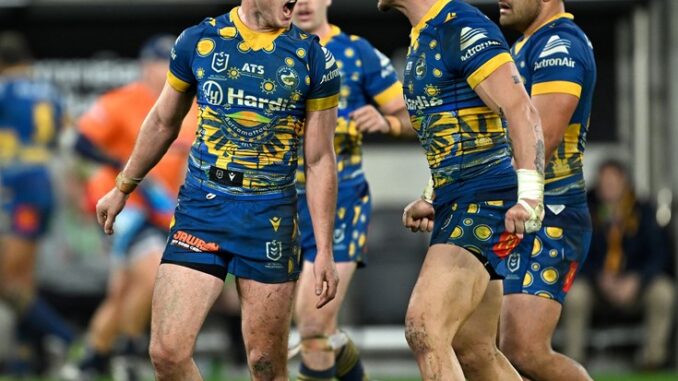
Bottom line: Four seasons, but pressure mounts each year” How long does Jason Ryles have to turn the Eels around” Eels board enters urgent meeting with expectation of….
When Jason Ryles signed a four-year deal as Parramatta Eels head coach starting from the 2025 season, he inherited a club steeped in both tradition and turmoil. Since being appointed in July 2024, Ryles has been entrusted with a long-term mandate—his contract running through to the end of the 2028 season . But exactly how long does he realistically have to reverse the club’s declining fortunes—and how is he going about it?
—
Setting the stage: diagnosis and expectations
The Eels are one of the game’s most storied franchises, yet have gone without a premiership since 1986. When Ryles took over, the club was reeling—just above the bottom of the 2024 ladder when Brad Arthur was sacked . Ryles’ appointment was hailed as a fresh start, intended to usher in a new culture and direction .
From the beginning, the board made clear—Ryles has time and trust to build something lasting. Four seasons may sound lengthy in modern footy, but expectations from a passionate fanbase and media can feel far more pressing.
—
Year One (2025): Culture, clarity and cutting the old guard
Ryles arrived with a plan—and he started with a clean slate. Long-serving players such as Clint Gutherson, Reagan Campbell-Gillard and Maika Sivo were allowed to leave. He offloaded high-earners to free up salary cap space, clearing around $3 million to reinvest . Still, departures meant losing experience: Gutherson’s exit in particular marked the end of an era .
Behind the scenes, he recruited a new coaching team—bringing in Nathan Brown, Scott Wisemantel, Sam Moa, and Nathan Cayless . He also looked to rebuild the leadership group: Mitchell Moses was made captain, with Juniors Paulo, J’maine Hopgood, and Jack Williams joining the leadership ranks .
Adding pace to the roster, Ryles signed Josh Addo-Carr and Zac Lomax and focused on recruiting mobility-focused players, signaling a tactical shift to “small ball” and agile play .
Although the season started disastrously—with a 56-18 drubbing by Melbourne in Round 1—Ryles earned his first win in Round 5 and helped guide the team to 14th on the ladder (6 wins, 12 losses) . Not spectacular, but a footing on which to build.
—
The longer view: Roadmap to 2028
Season 2 (2026): Stabilisation & player retention
This’ll be the season where momentum must grow. Standard expectations: improved ladder position, better consistency, and securing key players—especially contract decisions around Dylan Brown and Will Penisini. Brown, with a player option, must decide by Round 10 whether to extend to 2031 , while Penisini has shown intent to stay amid Ryles’ impact .
Season 3 (2027): Financial muscle and recruitment payoff
By now, the roster should reflect Ryles’ vision. With salary cap space from earlier cuts and likely maturation of drafted talent like Charlie Guymer, Saxon Pryke, Richard Penisini—all secured through to 2026 —the club should challenge finals if culture and systems are embedding effectively.
Season 4 (2028): Finals or bust
With full control of staff, roster, and culture, this is a “make or break” year. The Eels’ leaders—Ryles, Moses, and the coaching group—will be expected to deliver results. A finals berth would represent significant progress; a premiership would vindicate the rebuild. Anything less? Expectations and patience may wear thin.
What’s working—and what isn’t
Wins
Culture reset: Ryles’ early focus on culture and club engagement—players in community roles, legends returning to the fold—has resonated across Parramatta .
Roster rebuild: Strategic departures and fresh recruits show deliberate planning. Williams, Addo-Carr, Lomax and young talents signal a hybrid approach .
New coaching direction: The assistant coach lineup brings both NRL grit and international tactical insight .
Challenges
On-field results: The win-loss ratio in 2025 (6-12) is underwhelming but a baseline only .
Key contracts in limbo: The futures of Brown and Penisini are still unsettled, and losing either would sting.
Fan and media pressure: Despite backing, Eels culture means supporters expect rapid progress—not just structural shifts.
—
Bottom line: Four seasons, but pressure mounts each year
Ryles is firmly backed through 2028, giving him a four-year window to completely transform the club . That’s the formal term—but the real expectation clock ticks faster:
By 2026, expect a more competitive side and clarity around player futures.
By 2027, finals qualification should be the clear target.
By 2028, premiership contention must be within reach.
In short: four years to the contract end, but three years to build momentum—and immediate signs are both promising and incomplete. Ryles is no longer eating into goodwill. Now he must deliver wins to match the new culture he’s sparking
Leave a Reply